I must begin by confessing that my Konkani chicken curry is not based on some age-old recipe created by grannies, and that it may induce some lip curling among experts of Konkani cooking. And for that I apologise. This recipe is inspired by the Konkani style of dry chicken curries which have earned them legions of fans (myself included) who swear by their bright, bold and beautiful flavours.
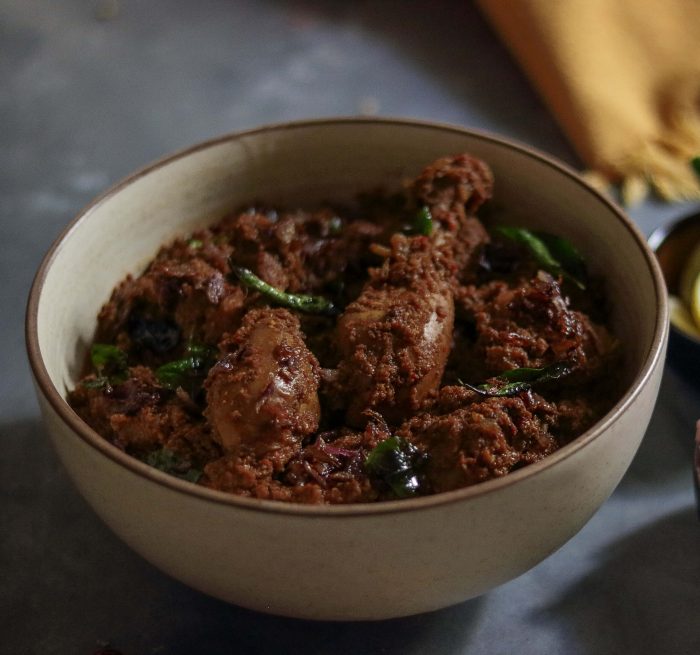
The western coast of India is home to some of the most delicious coastal cuisines – from Maharashtra, across Karnataka upto Kerala, the foods of the many communities that reside here, is rich, varied and complex. Some commonalities do exist though – the use coconuts in every form, a taste for dried red chillies both for colour and heat, love for seafood from the Arabian Sea, the popularity of souring agents such as tomatoes, tamarind, vinegar and kokum and an affinity for spices such as black pepper, cardamom, cloves and cinnamon, are the obvious ones. That being said, the foods and cuisines are far too diverse and complex to define and discuss in this post. Sufficeth to say that their culinary history is a testimonial to the influences of natural produce, agricultural practices, religious beliefs, foreign invasions and political regimes that helped them evolve over centuries.
Some ingredients typical to Konkani cooking
Red Chillies – Named after the town of Bydagi in Karnataka where it is grown, this bright red, wrinkly-skinned chilli is used liberally in the state’s cuisine and in this dish too. It’s only mildly hot and has meaty, vermilion flesh which on grinding turns into an attractive, red paste. Konkani dishes are famous for their colour, thanks to the Bydagi peppers.
Coconut – the scenic coasts of India’s western shores are lush with millions of coconut palms and coconuts are eaten all along these parts. Konkani cooking utilises both fresh and dried coconut flesh (copra), coconut milk, coconut cream etc. The taste and texture of dishes changes depending on this. Copra has a more intense, rich, oily taste (ideal for spicy, dark mutton and chicken curries) whereas fresh coconut is sweeter and more milky (better suited for seafood, vegetables and lentils).
Tamarind – Chinchamba is the Konkani name for tamarind and it is an important ingredient used in meat and fish curries as well as in many vegetarian dishes of koot, saaru, gojju and chutney. Tamarind is dried and sold in cake form and the older the tamarind, the darker is its colour. It’s soaked in water to extract its pulp.
Garlic – The celebrated chicken, meat and fish dishes of Konkan are incomplete without garlic. This humble bulb is a critical part of the masala or spice pastes that form the base of these dishes. Even vegetable preparations rely on garlic for umami and flavour. My Konkani chicken curry has a generous amount of garlic.
Spices – Coriander, black pepper, cumin, cinnamon, cardamom and cloves are precious to every Konkani cook. Different permutations and combinations of these spices give different masala pastes their unique taste, thereby distinguishing every curry with its own flavour profile.
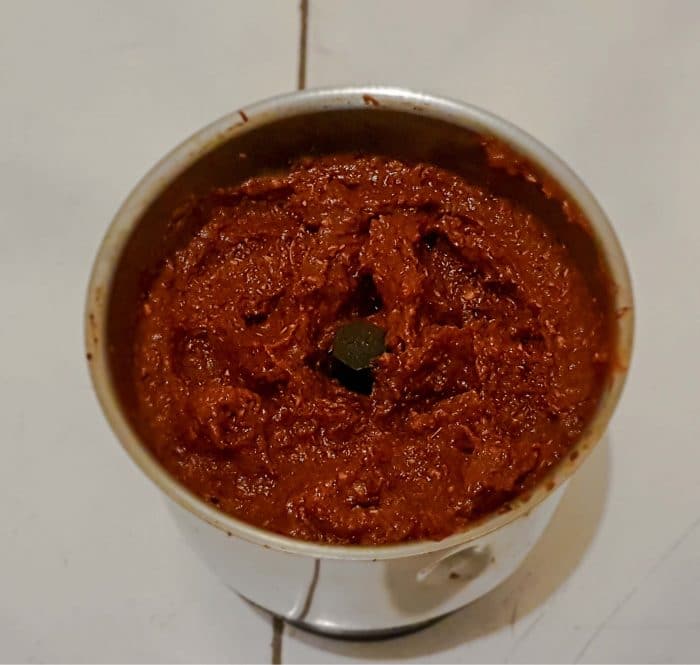
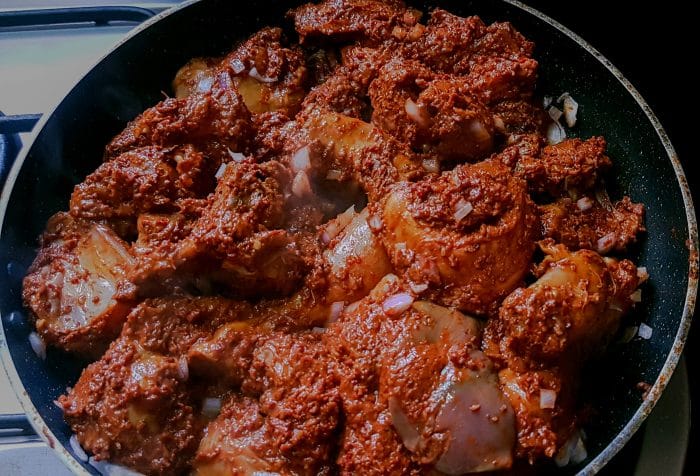
In this Konkani chicken curry, I’ve tried to evoke the deep, layered flavour of Konkani chicken sukka, a spicy, dark and thick, coconut and dried chilli-based chicken dish. The sauce here must envelop the chicken pieces in its warm, spice-scented embrace so that its intensity seeps into the flesh of the fowl. The pulpy Bydagi chillies, thick tamarind extract and freshly grated coconut help achieve this consistency. I’ve used 10-12 Bydagi chillies in this Konkani chicken curry but you can use a combination of hot Madras or Guntur varieties along with the Bydagi, if you want to crank up the heat.
Remember not to add too much water while grinding your masala paste. During the cooking process too, it’s important to add water in drips and drabs as you go along, instead of adding a lot at once. Trying to dry a runny curry will only result in overcooking the chicken, rendering it dry and chewy.
Dried tamarind can sometimes contain seeds, stalk, and fibrous threads and be hard to grind. So make sure to clean, and remove all seeds, skin etc and if it is too dry, soak it in a tablespoon of water for 10-15 minutes to soften it. Again, refrain from using too much water to avoid getting a watery masala.
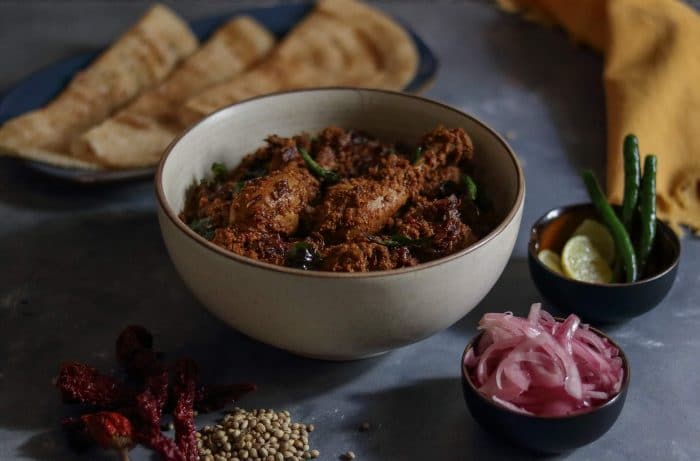
This coconut chicken recipe doesn’t take long to cook especially because I marinate the chicken overnight in the ground masala (again,not the traditional way but it helps build deeper flavours). Marinating tenderises the meat and prevents it from drying up. It’s also perfect for a Sunday lunch, because while the chicken is nestling in the marinade in the fridge, I can afford to sleep in (with the masala already ground), enjoy the Sunday newspaper and then cook lunch at a leisurely pace. Chicken sukka-style curries are made for neer dosas (we had them with regular dosas and pickled onions), they are equally delicious with all kinds of rotis and flatbreads besides plain rice, ghee rice and jeera rice.
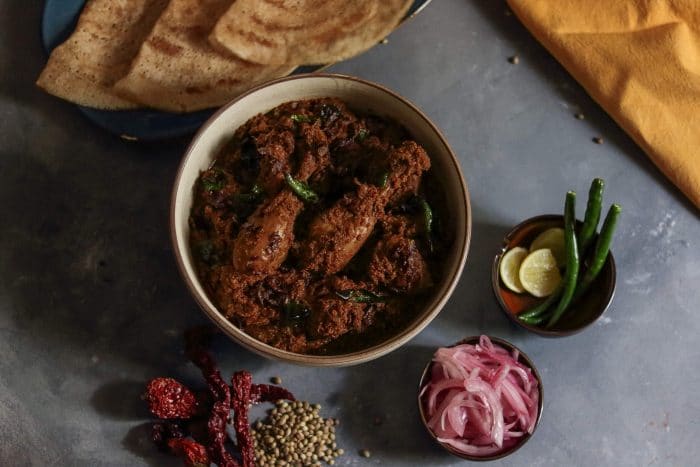
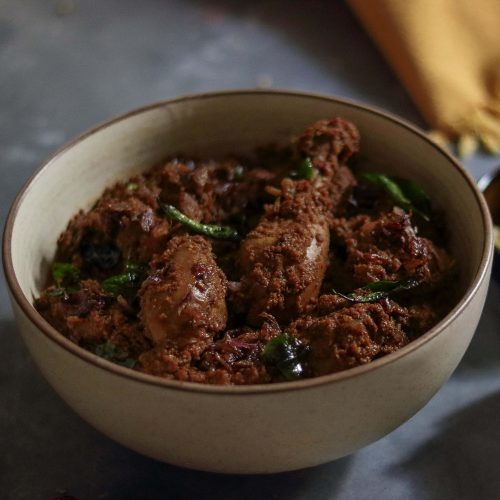
Konkani Chicken Curry
Ingredients
- 850 g skinless chicken on the bone, cut into medium sized pieces
- 3 onions, chopped
- 10 curry leaves
- 1½ tbsp vegetable oil
- 1 tbsp ghee
- ½ tsp garam masala
- Salt
For the masala paste
- 12 Bydagi or Kashmiri red chillies
- 3 tbsp coriander seeds
- 6 fat garlic cloves
- ½ tsp turmeric powder
- 1 tsp cumin seeds
- ¼ tsp fenugreek (methi) seeds
- ½ tsp aniseed (saunf)
- 10 black peppercorns
- 1½-inch piece of cinnamon
- 4-5 cloves
- 4 green cardamom pods peeled
- Walnut-sized lump of tamarind
For the coconut paste
- 8-9 tbsp fresh coconut, grated
- 1 tsp cumin seeds
Instructions
- Heat a tsp of oil in a skillet on low flame and lightly roast all the ingredients for the masala except the garlic, turmeric powder and the tamarind for 2-3 minutes taking care not to burn the spices. Cool and grind all the ingredients to a fine paste using a little water.
- Place the chicken in a flat dish, season with salt, mix in the ground masala paste, cover and marinate at least for 2 hours or preferably overnight in the fridge.
- Allow the chicken to come to room temperature before you begin cooking. Heat a tbsp of oil in a skillet or pan, add half the chopped onions and curry leaves and the chicken, mix well, cover and allow to come to a boil. Then lower the flame to medium and continue to cook the chicken in its own juices for 15 mins stirring intermittently. Add very small amounts of water only if required.
- While the chicken is cooking, grind the coconut and cumin seeds to a coarse paste using a little water. Set aside.
- Once the chicken is tender and about 90 per cent done, mix in the ground coconut paste and check the seasoning, add the garam masala and cook the chicken uncovered for another 10 mins till it is fully cooked and you have a thick gravy coating it. Take the pan off the heat.
- Heat the ghee in another pan and fry the remaining onions and curry leaves till the onions are golden. Pour over the chicken, mix well and serve.
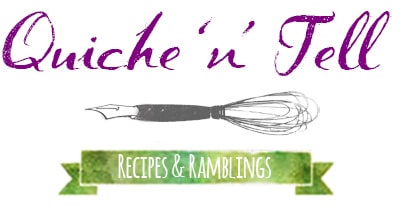




2 Comments
Medha Singh
April 13, 2021 at 5:32 pmI am a beginner and the detailed instructions provided in the blog allowed me to execute this dish to my satisfaction! This is truly a great help for everyone who wishes to explore and learn more about cooking. Thank you for bringing new recipes and cuisines to us!
quichentell
April 16, 2021 at 12:25 pmI’m so glad it worked to your liking Medha. Enjoy your cooking adventures.